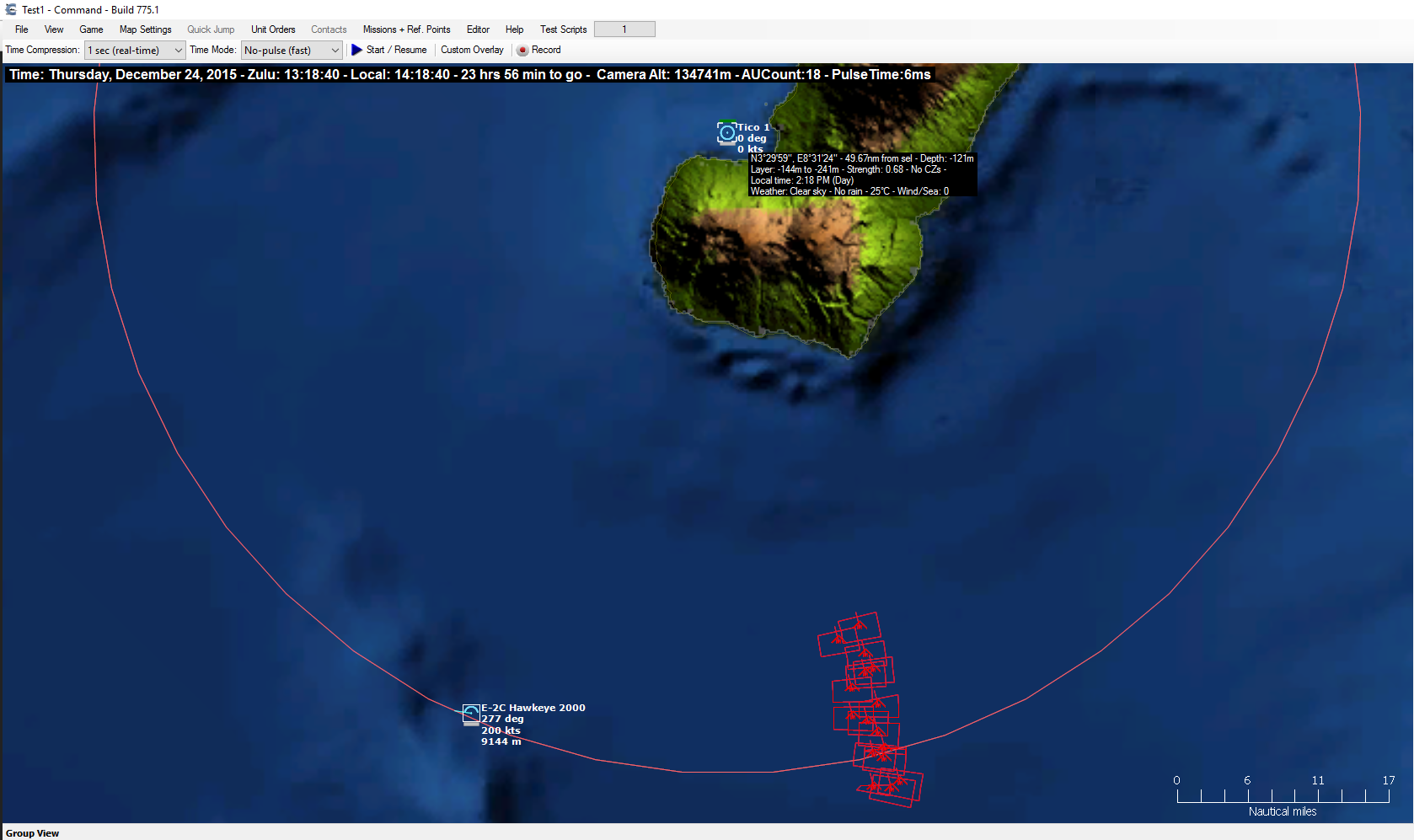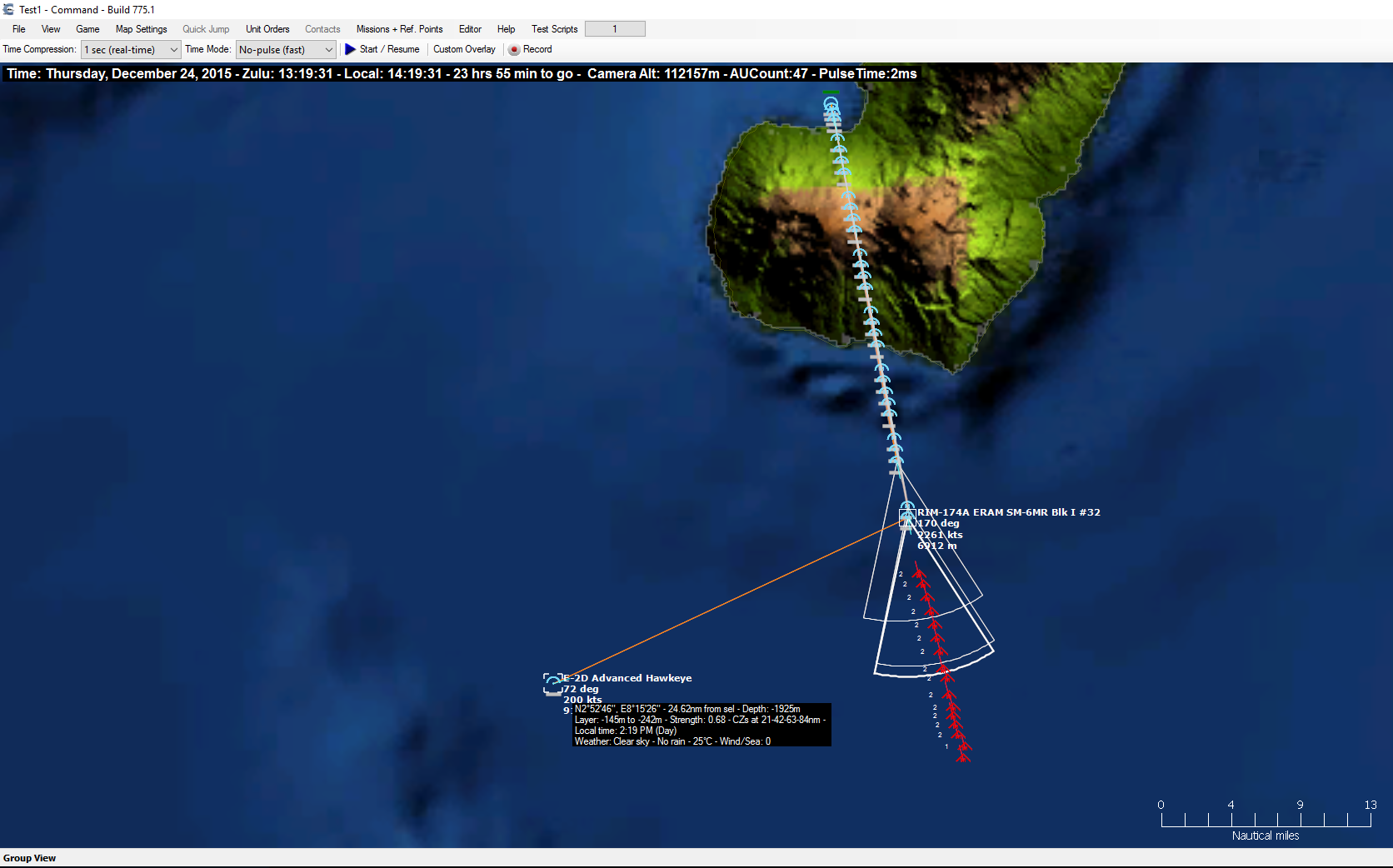The road to v1.10: New weaponry capabilities
Happy holidays everyone!
Command Build 757.12, which had been made available unofficially at the start of December, has now officially been released through MatrixGames and Steam. Barring any emergencies, this is probably the last update released as part of the post-v1.09/NI release support process (Command is still 50% off at MatrixGames and Steam until early January!). The development team’s focus is now the next major public update, designated v1.10. Let us take a look at the some of the major improvements that the new version will feature.
Cooperative Engagement Capability (CEC)
 New to the term? Here’s a quick primer. TL/DR version: You shoot the weapon (and often get out of harm’s way), I guide it to impact; typically by mid-course datalink, less frequently so by terminal illumination (e.g. radar or laser).
New to the term? Here’s a quick primer. TL/DR version: You shoot the weapon (and often get out of harm’s way), I guide it to impact; typically by mid-course datalink, less frequently so by terminal illumination (e.g. radar or laser).
Strictly speaking, this capability is not new. The Russian Navy already had since the early 1960s the ability to use its Tu-95RT Bear-D aircraft and Ka-25RT Hormone-B helicopters as airborne relays to “shepherd” heavy carrier-killer missiles launched from surface ships or submarines towards their targets. The US later introduced some weapons like the Walleye II ER-DL, the SLAM, the AGM-130 etc. which allow a different aircraft from the launch platform to guide them. And then of course there is the ubiquity of the buddy-lazing paradigm. What is new nowadays is that computers and networks have matured to the point where this guidance model is fast/responsive enough to be used against air targets.
Perhaps unsurprisingly, the first operational application of CEC emerged in Sweden in the late 90s, where Gripen-C/Ds of the Swedish air force were able to perform AMRAAM “blind shots” based on offboard shared data. But now with the emergence of NIFC-CA in the US Navy, CEC is going mainstream.
In a simulation like CMANO and its older siblings, it is tempting to take the “easy route” for modelling this ability by simply allowing everyone to guide everything. This creates problems in the sense that it does not really highlight the increased combat capability of the new systems. What is the AIM-120D good for (other than improved kinematics) if older versions of the AMRAAM offer the same guidance flexibility in-sim? So something stricter becomes necessary.
The implementation followed by the CMANO dev team allows great flexibility (database-wise) in defining that a given datalink component may allow cooperative use when installed in platform-A but not so when installed on platform-B. The same goes for different generations of the same basic weapon (e.g. AMRAAM-D vs. earlier versions). This allows modelling the differences in capability without having to spawn multiple versions (CEC-enabled and non-CEC) of the very same datalink system. It also highlights the necessity of bringing all the basic pieces together to really exploit the new functionality. For example an F-15C may tote the new AIM-120D but without any CEC-compatible platform (such as an E-2D or CEC-updated Aegis cruiser/destroyer) in the vicinity, it cannot really do a true launch-and-leave.
Let’s see how all these acronyms benefit the virtual commander. (Click for full size)
This is a typical nightmare scenario for an Aegis cruiser: The ship is operating in the littoral, close to high mountains that sharply reduce its visual and radar horizon. An attack by multiple supersonic sea-skimming missiles against the ship is underway. While the orbiting E-2C has provided early warning, this is not helping the ship significantly: the target tracks are imprecise and the Tico cannot engage the missiles because it is blocked by the mountains (the ship’s SM-2 missiles require terminal radar illumination). By the time the missiles pop over the mountain ridge and can be engaged, it will be too late.
Let’s observe the same situation with CEC-enabled assets in place.
The orbiting E-2D uses a new improved radar which enables establishing firm target tracks. The big change, however, is that now the cruiser has CEC-enabled datalinks and SM-6 ERAM missiles, and can start shooting them as soon as the inbound targets enter the kinematic envelope. Notice that most of the ERAMs are still in their midcourse phase (lofted high to maximize range) and still high enough that they can maintain their datalink (brown line) to the ship that launched them. However, the first-to-impact ERAM has already dived below the ship’s horizon and lost LOS to it and thus its connection to it – but the E-2D has taken over guidance for it (brown line between E-2D and ERAM). Effectively the ship is shooting blind and completely relying on the E-2D for guidance. And it works. This is CEC.
ABM Warhead Modifiers
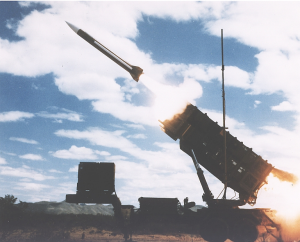 Q: So guys, how can we model the apparently mediocre performance of the Patriot PAC-2 in Desert Storm against Iraqi ballistic missiles?
Q: So guys, how can we model the apparently mediocre performance of the Patriot PAC-2 in Desert Storm against Iraqi ballistic missiles?
A: Well, I guess we can adjust the baseline Pk numbers and the max target speed values so that it behaves well against aircraft speeds but begins suffering at ballistic-speed targets.
Q: Okay, but won’t that also make it unrealistically ineffective against aerodynamic high-speed targets (e.g. SR-71)? From what we know, Patriot is quite effective against anything with wings.
A: True that. Okay, how about we set separate Pk baselines for air targets and missile targets.
Q: That might work, but then you have the problem that PAC-1/2’s handicap was not against missiles in general; it was specifically against ballistic targets. Its warhead, fuzing etc. were optimized against aerodynamic, winged targets and should have no problem working against e.g. cruise missiles (Patriot, like Aegis, was expressly designed with Soviet high-diver cruise missiles in mind). It had no problem intercepting the ballistic targets, but faced severe difficulty in actually destroying them. Most of them were knocked off course or broke up into multiple smaller but still lethal pieces.
Then you also have the factor of follow-on systems learning from the DS experience and improving on the ABM aspect. S-300VM/SA-23 for instance uses a directional-frag warhead (very much resembling a rotating claymore mine on top of a missile) and this has been also adopted by a few other systems, most notably Crotale NG and 9M96. And then of course you have the hit-to-kill trend nowadays with everything from PAC-3 to THAAD to even pure-AAW kits on the table. All these fancy new missiles aren’t actually much better than PAC-1/2 at hitting ballistic targets; they are however much better at actually blowing them away. And that’s to a large part due to their improved warheads. How do we show that?
A: ……..
(Yes, our brainstorming sessions are often like that)
So, we had to do something new. And we did.
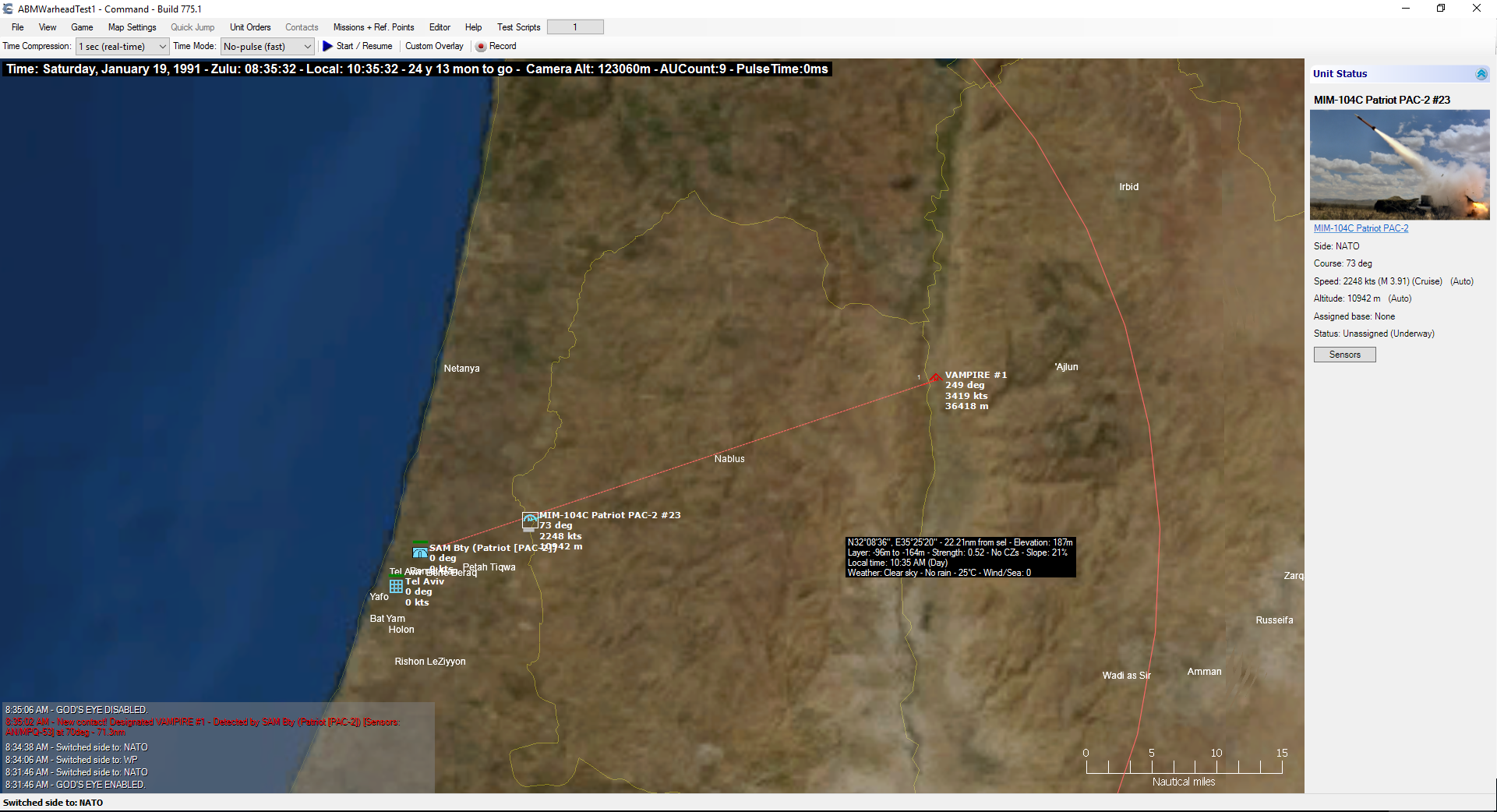 A familiar scene if you’re old enough: An Israeli PAC-2 battery in the outskirts of Tel Aviv engages an incoming Iraqi ballistic missile in the first days of Desert Storm.
A familiar scene if you’re old enough: An Israeli PAC-2 battery in the outskirts of Tel Aviv engages an incoming Iraqi ballistic missile in the first days of Desert Storm.
In addition to the standard continuous-rod warheads, we have added two more types of ABM-optimized warheads: Directional-fragmentation and hit-to-kill (HTK). We also modified the weapon-impact code to account for the special circumstances revolving engagements of ballistic targets (missiles & RVs).
This is what now happens when a SAM/ABM impacts an incoming missile/RV:
– A conventional warhead has a 15% chance of outright destruction of the target, and a 30% chance of significant trajectory deviation (CEP increased by 3x). If none of these happens then the target missile/RV suffers only a minor deviation (CEP increased by 1.5x).
– A directional-frag warhead has a 30% chance of outright destruction of the target, and a 60% chance of significant trajectory deviation (CEP increased by 3x). If none of these happens then the target missile/RV suffers only a minor deviation (CEP increased by 1.5x).
– A HTK warhead reliably destroys the target every time.
Trajectory deviations are cumulative, so an incoming missile/RV may be impacted multiple times by non-HTK ABMs and still survive but impact far away from its intended aimpoint (this happened in a few instances in DS).
AAW weapons with advanced warheads are also favored by AI crews in “best weapon to use” calculations, as their warheads also make them more lethal on anti-aircraft engagements (having your aircraft literally impaled by a HTK missile must be a relatively unpleasant experience…).
Weapons with advanced AAW/ABM warheads in the DB3000 database include:
- Arrow 3
- ASM-135A ALMV
- GBI [CE-I, GMD]
- GBI [CE-II Blk 0, GMD]
- GBI [CE-II Blk 1, GMD]
- KM-SAM [Modified 9M96]
- MIM-104F Patriot PAC-3 ERINT
- MIM-104F Patriot PAC-3 MSE
- R.440 Crotale-NG VT1
- R.440N Crotale-NG VT1
- RIM-161A SM-3 NTW Blk I
- RIM-161B SM-3 NTW Blk IA
- RIM-161C SM-3 NTW Blk IB
- RIM-161E SM-3 NTW Blk IIA
- SA-12a Gladiator [9M83]
- SA-12b Giant [9M82]
- SA-21a Growler [48N6DM]
- SA-23a Gladiator [9M83M]
- SA-23b Giant [9M82M]
- SA-25 [9M96]
- SA-25 [9M96D]
- SA-N-21c Growler [9M96]
- SA-N-21d Growler [9M96D]
- THAAD C-1
- THAAD C-2
One-click EMP strike
 EMP effects from nuclear detonations are not new; we introduced them already in v1.09 and they have been a lot of fun to use and experiment with. They were not however easy to use from an end-user perspective unless one was willing to get down and dirty with Lua in the scenario editor. v1.10 changes that. Now even aunt Elma can paralyze your country.
EMP effects from nuclear detonations are not new; we introduced them already in v1.09 and they have been a lot of fun to use and experiment with. They were not however easy to use from an end-user perspective unless one was willing to get down and dirty with Lua in the scenario editor. v1.10 changes that. Now even aunt Elma can paralyze your country.
The trick in smoothly integrating EMP attacks on existing weapon mechanics (and especially UI) is to make as few data changes as possible. In the real world, any nuclear warhead that can be lofted at high altitude (ideally near-orbital) is a crude but effective candidate for a continent-wide EMP strike (the physics of EMP propagation were a constant source of amusement during our research; the realization, for instance, that detonation altitude determines effective reach much more so than warhead yield). Would it be possible to simply make EMP-oriented copies of all nuclear ballistic missiles in the DB? It would, but it would create lots of logistical problems and would deprive players of the real-world flexibility of selecting the attack mode at the last possible moment.
So we created a framework for such “special mode” weapon attacks:
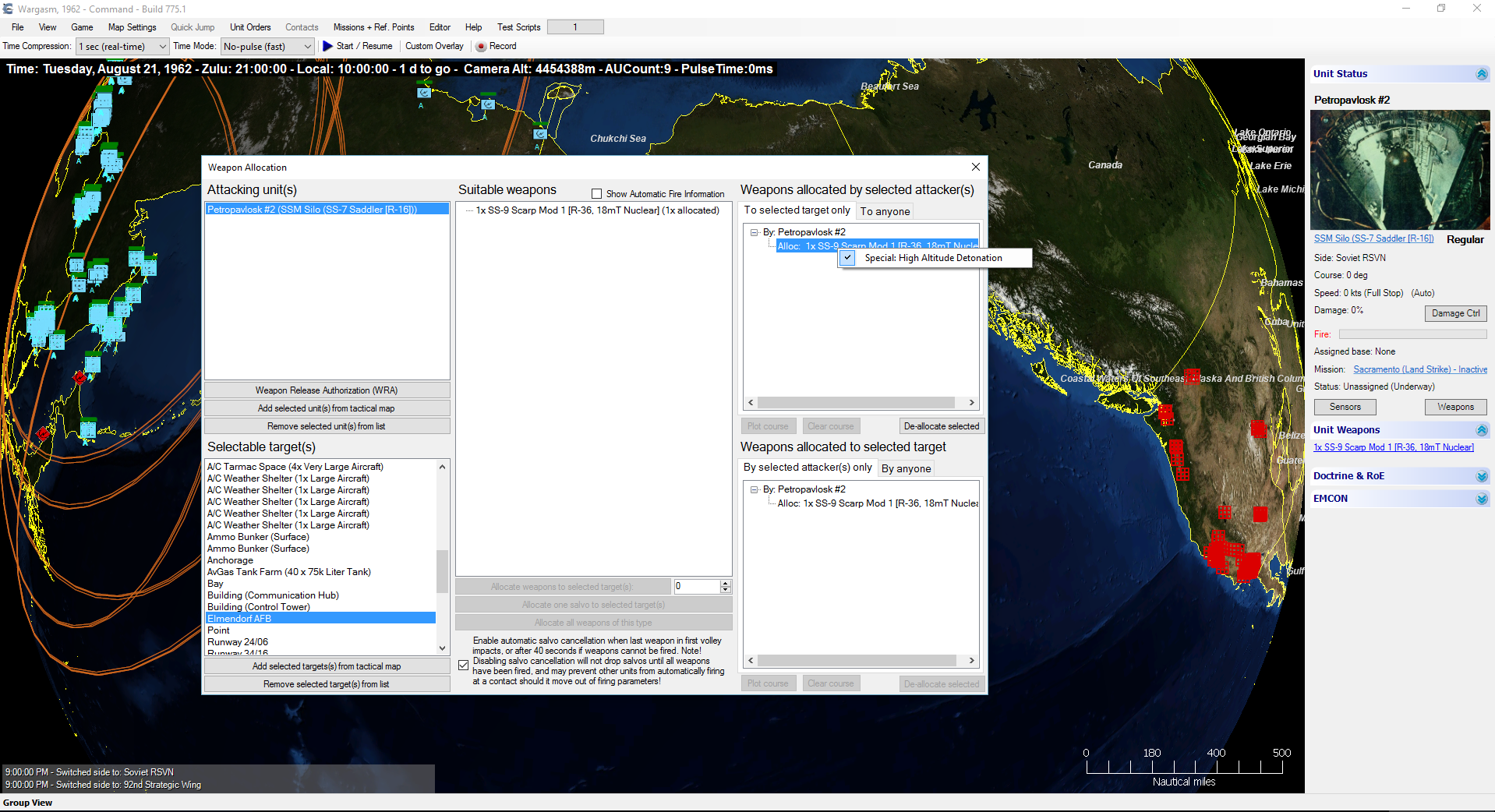 What is better than throwing a 18-megaton warhead at Elmendorf AFB? Why, bursting that same warhead high over Elmendorf and frying every transistor in Alaska and western Canada of course!
What is better than throwing a 18-megaton warhead at Elmendorf AFB? Why, bursting that same warhead high over Elmendorf and frying every transistor in Alaska and western Canada of course!
There is not much to say beyond the obvious: When you select this attack mode, the ballistic missile will detonate at high altitude instead of the normal low altitude airburst or groundburst (depending on target type) that nuclear warheads typically go off at. This ensures a powerful pulse extending out to more than a thousand km and knocking out sensors and communication systems. Such an “opening gambit” attack is in fact a common threat scenario when considering rogue nuclear states like Iran or North Korea.
Suffice to mention, the same framework can be re-used for other special weapon attack types in the future.
And there is much more to talk about….
Comments
Leave a Reply
You must be logged in to post a comment.




